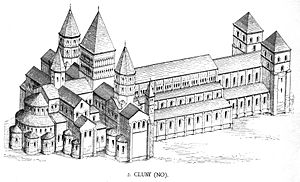
Pons of Melgueil
Encyclopedia

Abbot of Cluny
The Abbot of Cluny was the head of the powerful monastery of Cluny Abbey in medieval France. The following is a list.-List of abbots:-References:...
from 1109 to 1122. He was descended from a noble lineage of Languedoc
Languedoc
Languedoc is a former province of France, now continued in the modern-day régions of Languedoc-Roussillon and Midi-Pyrénées in the south of France, and whose capital city was Toulouse, now in Midi-Pyrénées. It had an area of approximately 42,700 km² .-Geographical Extent:The traditional...
which had long supported the Gregorian reform
Gregorian Reform
The Gregorian Reforms were a series of reforms initiated by Pope Gregory VII and the circle he formed in the papal curia, circa 1050–80, which dealt with the moral integrity and independence of the clergy...
. He himself was a godson of Pope Paschal II
Pope Paschal II
Pope Paschal II , born Ranierius, was Pope from August 13, 1099, until his death. A monk of the Cluniac order, he was created cardinal priest of the Titulus S...
.
Pons was elected to succeed Hugh of Semur
Hugh of Cluny
Hugh of Cluny was an Abbot of Cluny. He is sometimes referred to as "Hugh the Great" or "Hugh of Semur" and was canonized by the Roman Catholic Church as Saint Hugh . He was one of the most influential leaders of one of the most influential monastic orders of the Middle Ages.Abbot Hugh built the...
after the latter's death. For most of his abbacy he continued Hugh's policies: the construction of the third great abbey church of Cluny ("Cluny III"), expansion of the Cluniac order into northern France and England, and mediating the Investiture Controversy
Investiture Controversy
The Investiture Controversy or Investiture Contest was the most significant conflict between Church and state in medieval Europe. In the 11th and 12th centuries, a series of Popes challenged the authority of European monarchies over control of appointments, or investitures, of church officials such...
between Emperor
Holy Roman Emperor
The Holy Roman Emperor is a term used by historians to denote a medieval ruler who, as German King, had also received the title of "Emperor of the Romans" from the Pope...
and Pope
Pope
The Pope is the Bishop of Rome, a position that makes him the leader of the worldwide Catholic Church . In the Catholic Church, the Pope is regarded as the successor of Saint Peter, the Apostle...
. In 1120 Pons reconciled with Pope Calixtus II after a bitter quarrel. The result was the canonisation of Pons's predecessor and the raising of the Diocese of Santiago de Compostela to metropolitan status
Metropolitan bishop
In Christian churches with episcopal polity, the rank of metropolitan bishop, or simply metropolitan, pertains to the diocesan bishop or archbishop of a metropolis; that is, the chief city of a historical Roman province, ecclesiastical province, or regional capital.Before the establishment of...
for the benefit of Pons's friend, Diego Gelmírez
Diego Gelmírez
Diego Gelmírez was the second bishop and first archbishop of the Roman Catholic Archdiocese of Santiago de Compostela in Galicia, Spain. He is a prominent figure in the history of Galicia and an important historiographer of the Spain of his day...
.
In 1119 Pons's government was publicly protested by Bérard de Châtillon, the Bishop of Mâcon, and Humbaud, the Archbishop of Lyon. In 1122, on a pretext of extravagance, his own monks challenged his leadership and, receiving no Papal support, Pons was forced to step down. He tried to regain his position in 1125 but was imprisoned, in which state he died. Historians, by and large, have not accepted the official rationale for Pons's removal. Pietro Zerbi argued that he was the victim of opposition from the bishops disadvantaged by the many privileges his order received under his and Hugh's management. Adriaan Bredero believed he was brought down by a faction of reform-minded monks who desired to bring Cluny closer to the ideal of Cîteaux. Financial difficulties had also appeared for Cluny during Pons's abbacy, after Alfonso VI of León defaulted on his pledged annual donations (the so-called "Alfonsine census") in 1111. They did not resume, as the source of the monies, the parias
Parias
In medieval Spain, parias were a form of tribute paid by the taifas of al-Andalus to the Christian kingdoms of the north...
León had been collecting, had dried up c. 1100.

